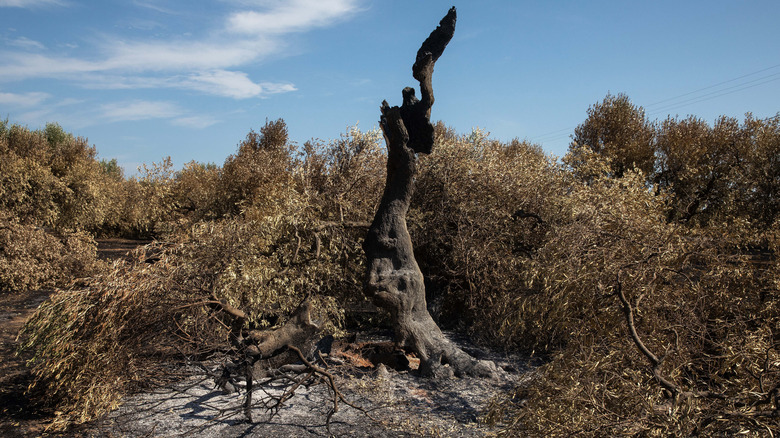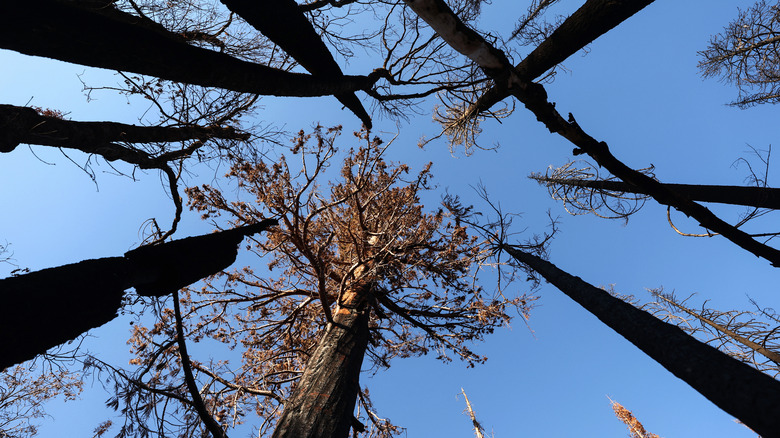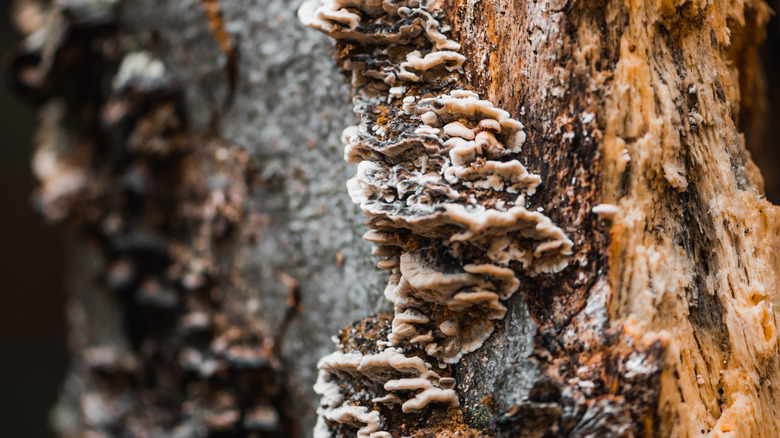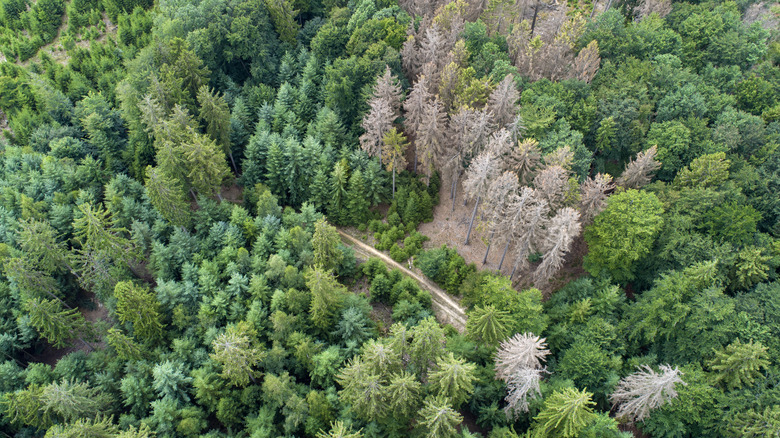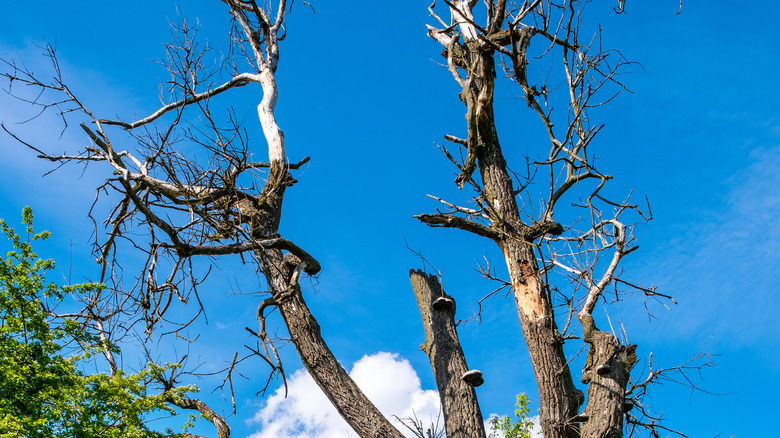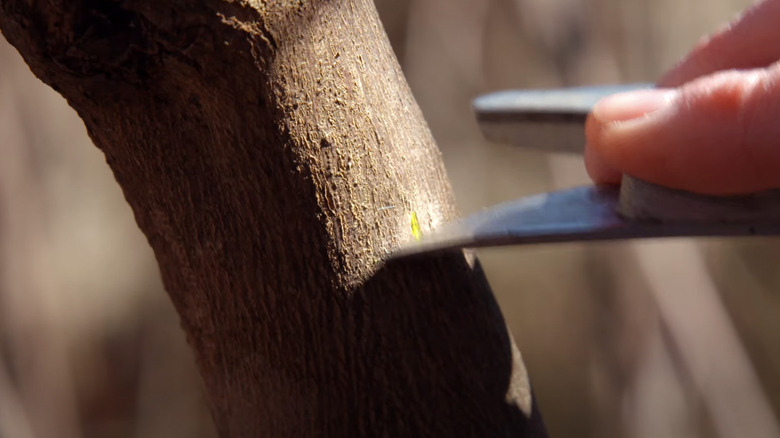How To Tell If A Tree Is Dead
It's spring and all the other trees in your yard are starting to be covered in new, bright green leaves. One of them is still bare. Is it dead? Is it still dormant? Can it be revived?
Inspecting the trunk can give you a good idea of whether or not the tree will come back. If you notice serious damage to the bark on the trunk, that's a bad sign. A tree without bark cannot survive. If you spot vertical cracks or splits in the tree, that could also be a sign of trouble. You may still be able to save a split tree, but you'll probably need the help of an arborist. Keep an eye out for long streaks of missing bark on the trunk — that could mean that the tree was struck by lightning.
There are many different types of trees so beyond any obvious signs of damage, it can be difficult to know what is normal and what is a sign that your tree is dying, or even already dead. If inspecting the trunk doesn't give you the answer, here are a few more ways to check if a tree is dead or not.
Check out the leaves
Deciduous trees, a group which includes maples, beeches, and oak trees, all lose their leaves in the cold weather, so not seeing leaves on the tree is not automatically a sign that the tree is dead — but depending on what time of year it is whether or not the tree has leaves can be a good indicator of whether or not the tree can be revived.
Generally, trees will grow new leaves in the spring, have full foliage in summer, start losing leaves in fall, and be barren in winter. There is some variation by species, but in general, if a tree isn't following this pattern something is wrong. For instance, if a tree has no leaves in mid-summer, it is likely dead. The presence of leaves on a tree does not necessarily mean everything is alright with it, however. If a tree has full but wilty or dead-looking leaves in mid-winter, the tree is suffering, but not necessarily dead. Environmental stressors like drought or damage to the roots can cause this.
Does it have mushrooms or fungus?
Seeing mushrooms on your tree doesn't always mean that it is dying, but taking note of any fungi that you see can help you determine if the tree is in danger or if it is already too late. If there are many mushrooms growing close to the tree or on it, that is a sign that there is a lot of decaying wood for spores to latch onto. Mushrooms are not the cause of the tree's death, but they will speed it up by decomposing the wood quickly. Your tree may not be quite dead yet and in some cases could stand and continue to grow leaves for many years, but seeing many mushrooms on it is a sign that it is actively rotting.
You should also take note of mushrooms growing on the soil around the base of the tree, as it can indicate that the roots have rotted. You will want to dig a little and see if they are growing directly out of the tree roots before worrying, though. Mushrooms in the soil can actually make it healthier. Without looking at the roots, it's hard to say if the mushrooms are helping or hurting your tree.
What about pine trees?
Evergreen trees do not lose their needles in the fall or have bare branches in the winter. Sometimes a pine tree suddenly drops a lot of needles, turns brown inside, and seems to have a lot of dead branches near the trunk. This is not necessarily a sign that the tree is dead or dying, just that those inner branches cannot get enough sunlight because of the shade of the outer branches. If you're noticing the outer branches turning brown and dropping needles instead, the tree may soon be dead.
Pine trees that are dead or dying often end up being food for many kinds of beetles. If you're seeing spots where droplets of pitch have come out of the tree bark, it has been attacked by beetles. If it is white, the tree likely kept the beetle out, but if the pitch looks red or brown, the beetle made it inside. If you're seeing a lot of brown pitch on the trunk accompanied by sawdust and holes left by woodpeckers looking to eat the beetles, the tree is very likely dead or will die very soon
Check the branches
If you are seeing signs that your tree may have died, it's time to start doing some tests. One way to check is to see if there are any new buds waiting to come out on the branches. Even a tree that is dormant will have some small buds for new leaves to grow in the future. If you don't see any, or they look like they have dried up, the tree may already be dead.
You can also test to see if the branches are flexible. If you bend a small branch, it shouldn't break easily. If it quickly snaps when you pull it back, the branch is probably dead. Keep in mind that some branches of a tree can be dead without the entire tree being dead, however, so it's important to keep in mind the overall state of the tree when testing individual branches.
Scratch the bark
The scratch test is one of the most effective ways of determining if a tree is actually dead. From the outside, a dormant tree can look a lot like a dead tree, but inside there is living tissue. When you do a scratch test, you make a small cut in the bark and see what's going on inside for yourself.
You can start with a new branch and scratch the bark away with your fingernail. If that doesn't work, you can use a small knife to cut away a little bark — just be careful not to cut so much as to harm the tree if it is still alive. If the tree is living, you will see a light vibrant green inside. If it is dead, it will be brown and dry. Be sure to check in several places on the tree before declaring it dead, as it is possible for some branches to die while the tree is still alive.
